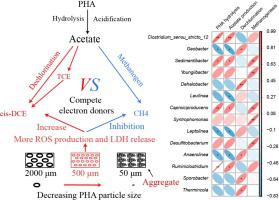当前位置:
X-MOL 学术
›
Chem. Eng. J.
›
论文详情
Our official English website, www.x-mol.net, welcomes your feedback! (Note: you will need to create a separate account there.)
Strategies and mechanisms for improving groundwater remediation efficiency of chlorinated ethenes by controlling the particle size of polyhydroxyalkanoate
Chemical Engineering Journal ( IF 13.3 ) Pub Date : 2024-07-15 , DOI: 10.1016/j.cej.2024.154038 Jie Ma , Linhui Lei , Zhiwei Gong , Zongping Wang , Hui Liu , Guanghao Chen , Gang Guo
Chemical Engineering Journal ( IF 13.3 ) Pub Date : 2024-07-15 , DOI: 10.1016/j.cej.2024.154038 Jie Ma , Linhui Lei , Zhiwei Gong , Zongping Wang , Hui Liu , Guanghao Chen , Gang Guo

|
The efficacy of in-situ bioremediation of chlorinated ethenes (CEs)-contaminated groundwater is heavily contingent upon the provision of exogenous electron donors to facilitate reductive dechlorination by dechlorinating bacteria. Nonetheless, methanogenic archaea have been reported to engender competition for the limited electron donor supply, thereby diminishing dechlorination efficiency. This study proposes a novel strategy to enhance reductive dechlorination by reducing the particle size of polyhydroxyalkanoate (PHA) to the micrometer scale, thereby inhibiting methanogenic competition for electron donors. The results demonstrate that trichloroethylene (TCE) biodegradation efficiency peaked at a PHA particle size of 500 μm, significantly surpassing the efficiency observed in groups with particle sizes of 50 and 2000 μm. Furthermore, the electron utilization efficiency of dechlorinating bacteria (represented by , , , etc in this study) was as high as 94.82 % over methanogenic archaea (represented by ) in the 500 μm group. Mechanistic analyses revealed that the 500 μm PHA particles activated dark oxygen, leading to the generation of reactive oxygen species that decreased the abundance of the methanogenic functional gene and increased the abundance of dechlorinating functional gene relative to the total microbial genome gene (in terms of 16S rRNA). In contrast, PHA particles of 50 μm exhibited lower TCE biodegradation efficiency due to particle aggregation, while particles of 2000 μm exhibited reduced efficiency due to lower specific surface area. This study moves a step for the in-situ microbial remediation of CEs-contaminated groundwater.
中文翻译:

控制聚羟基脂肪酸酯粒径提高氯化乙烯地下水修复效率的策略和机制
受氯化乙烯(CE)污染的地下水原位生物修复的效果在很大程度上取决于提供外源电子供体以促进脱氯细菌的还原脱氯。尽管如此,据报道,产甲烷古菌会引发对有限电子供体供应的竞争,从而降低脱氯效率。这项研究提出了一种新策略,通过将聚羟基脂肪酸酯(PHA)的粒径减小到微米级来增强还原脱氯,从而抑制产甲烷菌对电子供体的竞争。结果表明,三氯乙烯 (TCE) 生物降解效率在 PHA 粒径为 500 μm 时达到峰值,显着超过在粒径为 50 和 2000 μm 组中观察到的效率。此外,脱氯细菌(本研究中以 、 、 等为代表)的电子利用效率比 500 μm 组中的产甲烷古菌(以 为代表)高达 94.82%。机理分析表明,500 μm PHA 颗粒激活暗氧,导致活性氧的产生,从而降低了产甲烷功能基因的丰度,并增加了相对于总微生物基因组基因的脱氯功能基因的丰度(以 16S 计)核糖核酸)。相比之下,50 μm 的 PHA 颗粒由于颗粒聚集而表现出较低的 TCE 生物降解效率,而 2000 μm 的颗粒由于较低的比表面积而表现出较低的效率。这项研究为原位微生物修复受CEs污染的地下水迈出了一步。
更新日期:2024-07-15
中文翻译:

控制聚羟基脂肪酸酯粒径提高氯化乙烯地下水修复效率的策略和机制
受氯化乙烯(CE)污染的地下水原位生物修复的效果在很大程度上取决于提供外源电子供体以促进脱氯细菌的还原脱氯。尽管如此,据报道,产甲烷古菌会引发对有限电子供体供应的竞争,从而降低脱氯效率。这项研究提出了一种新策略,通过将聚羟基脂肪酸酯(PHA)的粒径减小到微米级来增强还原脱氯,从而抑制产甲烷菌对电子供体的竞争。结果表明,三氯乙烯 (TCE) 生物降解效率在 PHA 粒径为 500 μm 时达到峰值,显着超过在粒径为 50 和 2000 μm 组中观察到的效率。此外,脱氯细菌(本研究中以 、 、 等为代表)的电子利用效率比 500 μm 组中的产甲烷古菌(以 为代表)高达 94.82%。机理分析表明,500 μm PHA 颗粒激活暗氧,导致活性氧的产生,从而降低了产甲烷功能基因的丰度,并增加了相对于总微生物基因组基因的脱氯功能基因的丰度(以 16S 计)核糖核酸)。相比之下,50 μm 的 PHA 颗粒由于颗粒聚集而表现出较低的 TCE 生物降解效率,而 2000 μm 的颗粒由于较低的比表面积而表现出较低的效率。这项研究为原位微生物修复受CEs污染的地下水迈出了一步。












































 京公网安备 11010802027423号
京公网安备 11010802027423号